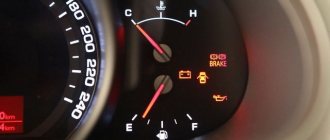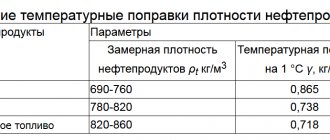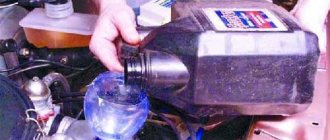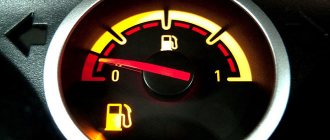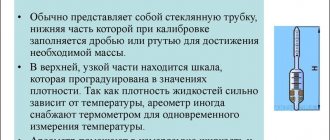Gasoline fuel is a fraction made from petroleum and is used as vehicle fuel. The main and most valuable feature is the ability to easily mix with air. Of all types of flammable liquids, it has the greatest resistance to frost. Many car enthusiasts have wondered, what is the freezing point of gasoline? Under conditions of absolute quality, the absence of additives and additives, the average value of the thermometer column at which AI freezes - 92, 95, 98 is equal to -72 °C.
Do not think that the substance turns into ice; the fuel becomes a jelly-like consistency. According to the laws of physics, in this state of aggregation the ability to mix with air is lost and the liquid loses its basic properties. Does gasoline freeze in the cold? In the middle zone, where winter is not so severe, fuel will not be able to freeze. If your car runs on diesel fuel, you should know that diesel freezes at -35°C. Be careful, as in the northern and central regions of Russia these are quite real frosts for the winter period.
What is the freezing point of gasoline?
The fuel froze as it turned into a thick, jelly-like substance. The freezing point is AI -95, if clean, it is minus 70 C. If the supply of fuel to the injector and carburetor suddenly stops in the cold, it is worth checking the quality by checking the pour point of a specific brand of gasoline in the tank.
Frost will have a significant effect on the structure of the chemical substance. The modern fuel mixture is a complex combination of highly volatile hydrocarbons and catalytic additives; the latter may not withstand the surge. The molecular structure degrades, the fuel mixture simply loses its properties, so that it cannot be used for its intended purpose.
Damage will be caused to sensors and contacts that will fail when frozen. After defrosting, it is necessary to carry out a full diagnosis of the system for damage.
Is it possible to encounter a problem when using proven fuel?
The likelihood of encountering the problem of frozen gasoline in winter when using high-quality fuel is almost zero. Even if bad fuel is used, it is difficult to encounter it freezing in the gas tank. In most cases, the use of bad gasoline primarily leads to problems with individual components and assemblies of the car.
Additives are usually added to high-quality fuel, which significantly lower the threshold temperature for changes in fuel quality for the worse. At trusted gas stations, they fill with frost-resistant gasoline with an octane rating of 80 to 98. This means that a person who uses refueling services from trusted companies significantly reduces the likelihood of encountering a problem.
The low risks when using good fuel are primarily associated with the high threshold value of the freezing point of gasoline and the small number of truly cold regions in the country in which the thermometer can drop below 50 degrees. It is worth noting that the car stops starting at higher temperatures than gasoline freezing. It is this problem that worries a person in the first place.
What to do if the fuel in the tank is frozen
Normally, moisture is present in any fuel tank, but water does not always have a negative effect on engine performance. As has already been found out, gasoline freezes at a temperature of minus 60 C. If it is discovered that the fuel in the tank has become thick or completely frozen, then it is necessary to take measures to eliminate what happened. Start warming up the car in every possible way. Use an electric hair dryer, drive the car to an underground parking lot or a heated garage. After defrosting, drain the low-quality fuel and fill it with new one. If you use diesel fuel, it has a greater chance of freezing. If signs of icing appear, pour half a spoonful of engine oil into the tank of a diesel car. The moisture will evaporate after the emulsion burns.
https://www.youtube.com/watch?time_continue=165&v=wdSJtp9i5x0&feature=emb_logo
Table values
Basic measurements for diesel fuel are carried out at an ambient temperature of +20C. This is due to GOST. You should also take into account the brands of fuel, because they have their own physical characteristics. If you need a value regardless of temperature, you can find it out from the following table.
| Brand name | Density, kg/m3 | Measurement temperature, C |
| Summer d/t | 860 | +20 |
| Winter d/t | 840 | +20 |
| Arctic d/t | 830 | +20 |
Based on the values, it is obvious that the density of winter diesel fuel is clearly less than the parameter for the summer grade of fuel. This ensures better fluidity of the liquid and reduces its pour point.
According to established standards, a summer grade should, under normal conditions, have a specific gravity of 8440 N/m3. A similar indicator for winter d/t is determined as 8240 N/m3.
You can independently weigh a clearly measured liter of fuel. It should reach the scale mark of 830-860 g, depending on the type.
It is worth knowing that summer diesel fuel in our country is marked with the letter “L”.
In the Middle Zone, this type is offered at gas stations from April to early to mid-autumn. It is important that the ambient temperature is not recorded below -5C (at -6C cloudiness occurs). When the value drops below -7-8C, the risk of liquid freezing increases significantly. As a result, blockages occur in the pipelines.
The density of diesel fuel varies slightly depending on temperature (the table of brands is indicated above). One degree leads to a change in density by 0.75 kg/m3. A more detailed plate can be downloaded from the link.
What are the symptoms of a frozen fuel line?
It is impossible to talk about the symptoms of frozen gasoline. Long before gasoline freezes inside a car, the first elements to freeze are water and water vapor. So let's talk about the signs of a frozen fuel line instead. After all, the point of the question “At what temperature does gasoline freeze?” designed to prevent serious problems that car owners may encounter in winter.
When water and water vapor freeze inside the car, they block gas from the fuel line from reaching the engine. To tell if your gasoline is blocked by frozen water, look for the following symptoms:
Constant stopping or splashing while driving
Some people need to drive even if it gets unbearably cold outside. The bad news is that no matter how much heat your car generates while you drive, your gas tank can still freeze. You will know for sure if the tank is no longer working due to the cold. The car began to stall or snort. In fact, even if there is nothing wrong with the cylinder, a frozen gas line can still cause this symptom.
Failure to start
Don't worry too much if the engine doesn't start. While it may still turn over, just wait until the temperature gets high enough. Be patient and your car will be able to work normally even if it's freezing outside. As you can see, you can’t wait until the gas in your car freezes. Just take care of your car more often in winter.
Failure to turn over
While the fuel line is still frozen - not completely frozen yet - the engine can still turn over, even if it can no longer start. You would know if the fuel line is already in worse condition unless the engine completely turns over. Don't worry; There are ways to fix a frozen fuel line.
Reviews and recommendations from car owners.
Ivan: From personal observation, I will say that the critical temperature for summer diesel fuel is minus 10 °C, and at minus 10-15 °C problems begin with the fuel filter - it becomes clogged with thick paraffin flakes. In the 90s, foreign cars running on diesel fuel were already equipped with a heated fuel filter. Nowadays, diesel fuel is often bad and you can’t get enough anti-gel for it. Therefore, I chose one gas station, where they more or less don’t fill up, and that’s the only place I refuel.
Vladimir Evgenievich: I had such a problem once and it was only minus two. No fuel was supplied. I had to unscrew the tubes with the mesh from the tank. I immediately saw some kind of lump of matter with ice pieces on the mesh. Maybe even earlier liquid got into the tank along with this rag. Now I don’t lose my vigilance, I often look into the filter.
Egor: I consider diesel fuel a waste product from oil refining. If it is clean, without any impurities, then at our usual winter temperatures it cannot freeze. Gasoline will not freeze even at minus 40.
But if any obscene rubbish is added to diesel, for example paraffin or water (we often do this at gas stations), then minus 20 will be enough to freeze. Then both the engine and the car owner will have problems.
Sergey: Different types of fuel have their own temperature regimes. So summer diesel fuel is designed for operation within - 5 to - 7 degrees.
Winter - it will freeze already at -30 - -35 degrees.
Special, Arctic - only at - 50 degrees.
All car owners should know this so that they don’t have any difficulties or troubles in cold weather.
Didn't find the information you are looking for? on our forum.
Kinds
All the most common types of gasoline are produced in 2 versions: winter and summer. They differ from each other like day and night. Due to various additives. If in the summer they try to lower the boiling threshold, then in the winter they lower the thickening threshold. At the same time, you still need to manage not to violate the threshold of its flammability. Otherwise, gasoline will turn from fuel into a useless antifreeze liquid poured into your tank. Drivers' love for switching from summer to winter fuel by refueling leads to a lot of problems.
Such as freezing of the fuel filter and the appearance of ice in the float chamber. Remember, a winter-summer gasoline cocktail freezes perfectly even at -9°C. But still, most often the culprits in the appearance of such cocktails are dressings. Where they also like to mix these gasolines.
Does it freeze?
In physics there is such a thing as absolute zero. It is equal to -273°C. So, under these conditions, absolutely everything will freeze. But since you and I do not encounter absolute zero, then there is accordingly nothing to be afraid of. Under our conditions, freezing (that is, crystallization) of gasoline is impossible. But with a certain decrease in temperature it begins to thicken. It turns into a viscous jelly-like mass. So, it is precisely the temperature of transition to critical thickening (-60°C) that is conventionally called freezing.
In this form, gasoline is absolutely impossible to pump through the fuel system. For areas where there is a risk of such temperatures, a special type of gasoline called “Arctic” is produced.
Storage containers
Considering the fact that the shelf life of gasoline in a car tank is short, fuel can be stored in special cans and metal barrels. Some car owners store fuel in plastic bottles, but it is better not to do this, as gasoline reacts with plastic and accumulates a static charge. This happens very slowly, but plastic containers are still not suitable for storage. Theoretically, if a static charge accumulates, a spark may occur when gasoline is poured from a plastic container into the tank. Therefore, it is prohibited to store fuel in this manner.
Otherwise, the shelf life of gasoline in plastic containers will be approximately the same as in metal containers.
- Above ground metal tanks.
- Tankers and barrels.
- Buried tanks.
- Canisters.
As for storing gasoline in a canister, this is allowed, but the shelf life of the fuel in this case will be short. The best option is a tank buried in the ground, which is hidden from the sun and cooled by the soil. At home, people often resort to another option: they bury a metal barrel in the ground and seal it with a lid. This option for a permanent fuel tank is not bad.
Tightness
If the container is not sealed, the fuel will evaporate. Moreover, the higher the temperature, the faster. Gasoline contains highly evaporating fractions that increase the octane number. Ensure tightness and you will preserve the quality of stored fuel longer.
To reduce interaction with air, containers must be filled with fuel to 95 percent.
In addition, when interacting with air, gasoline will oxidize. The use of oxidized fuel reduces the service life of vehicle systems, leads to the deposition of resins inside the engine, carbon deposits in the cylinders and on spark plugs.



